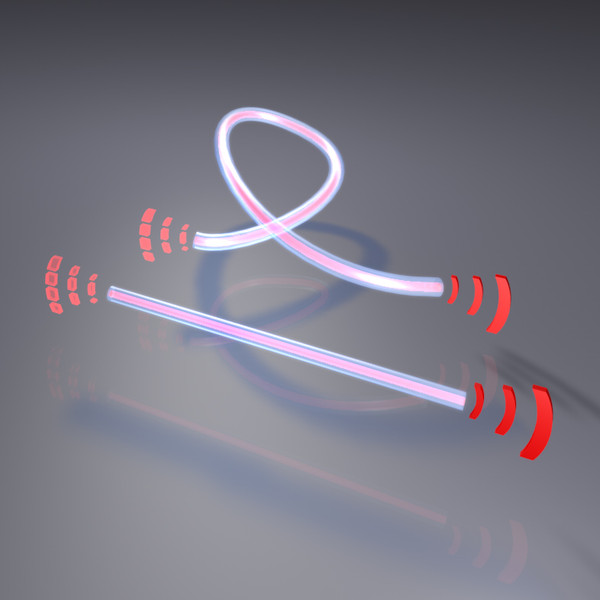Sharp images with flexible fibers

Optical waveguides with a perfectly parabolic refractive index profile are almost immune to bending, conserving the transmitted image information. Source: Leibniz-IPHT
Endoscopes allow doctors to see into a patient’s body like through a keyhole. Typically, the images are transmitted via a bundle of several hundreds of optical fibers. They account for the relatively large diameter of the endoscopes that hampers their application in sensitive body regions such as the brain.
A team of international researchers around Prof. Tomáš Čižmár, scientist at Leibniz IPHT, studies multimodal optical fiber probes, in which high-resolution images can be transmitted through just one single hair-thin fiber. For applications such as the survey of single brain cells ‘at work’ in a living organism, the probes must be first and foremost flexible. This is a challenge, as with the bending of the fiber the transferred image is distorted in several ways.
For several years Čižmár already works on a solution to optimize the transfer of image information in multimodal fibers. “Previously, we have shown that the influence of bending on the light propagation can be predicted and the image restored using computer calculations. But the correction is very complicated and we need to know the exact shape of the probe”, explains Čižmár, who heads the Fiberoptics department at Leibniz IPHT since 2017.
Now, the scientists discovered that fibers exhibiting a specific refraction index profile provide a new and much more simple approach. “We came to the idea to use gradient index fibers for image transfer. Other than in common fibers, the light refraction across the fiber diameter does not change abruptly, but gradually in shape of a curve”, says Čižmár. Firstly, the researchers simulated the light propagation in the fibers with theoretical models.
The results suggested that the signal transmission in the fibers is almost immune to movement and bending due to the unique refraction index profile. “In experiments, we managed to proof our ideas only partially. The graded index fibers are indeed much less sensitive towards deformation compared to conventional step index fibers.
Nevertheless, we observe a residual slight distortion of the images, which we assign to deviations from the ideal parabolic refraction index profile of the commercial fibers”, explains first author of the publication Dirk Boonzajer Flaes the extraordinary results. The researchers focus now on the development of gradient index fibers with enhanced optical properties and their application for medical imaging.
The original article “Robustness of light-transport processes to bending deformations in graded-index multimode waveguides” by Dirk E. Boonzajer Flaes, Jan Stopka, Sergey Turtaev, Johannes F. de Boer, Tomáš Tyc, and Tomáš Čižmár appeared online in Physical Review Letters on 6th June 2018.
https://www.leibniz-ipht.de/en/institute/presse/news/detail/scharfe-bilder-mit-f…
https://journals.aps.org/prl/abstract/10.1103/PhysRevLett.120.233901
Media Contact
All latest news from the category: Physics and Astronomy
This area deals with the fundamental laws and building blocks of nature and how they interact, the properties and the behavior of matter, and research into space and time and their structures.
innovations-report provides in-depth reports and articles on subjects such as astrophysics, laser technologies, nuclear, quantum, particle and solid-state physics, nanotechnologies, planetary research and findings (Mars, Venus) and developments related to the Hubble Telescope.
Newest articles

Detector for continuously monitoring toxic gases
The material could be made as a thin coating to analyze air quality in industrial or home settings over time. Most systems used to detect toxic gases in industrial or…

On the way for an active agent against hepatitis E
In order to infect an organ, viruses need the help of the host cells. “An effective approach is therefore to identify targets in the host that can be manipulated by…

A second chance for new antibiotic agent
Significant attempts 20 years ago… The study focused on the protein peptide deformylase (PDF). Involved in protein maturation processes in cells, PDF is essential for the survival of bacteria. However,…





















